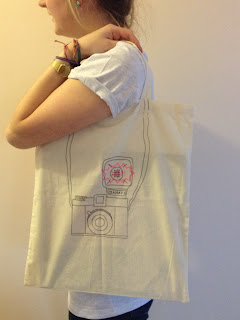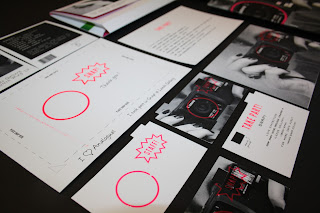I have defiantly learnt new skills in the way I generate concepts and how this then influences my designs. I used to look at definitions and thesaurus last year but I lost that this year until we did the workshops. It has enabled me to think more creatively about concepts, approach them differently and has informed my designs. I think I effectively applied this particularly to what is good as I initially looked into a range of ways to approach this brief e.g. packaging, exhibition etc. Then when I had chosen my direction of an exhibition, in easter I thought through lots of different concepts for what the exhibition could be. From this I chose three and sketched ideas of how the concept could be applied to different formats. This meant I was prepared for the concept crit and the feedback really informed my next decisions as well as strengthened my concepts more. By having the concept in order it meant I could strengthen it and apply it more effectively with more time to the designs and formats. This can be seen in the atheistic of my products as well as the context and format they take. Another skill is organisation as this module was aligned with a lot of others and deadlines of modules. As I had big ambitions for this project of producing several different formats, which isn't my forte, screen printing, again not my strongest and lack of experience, and stitching which is incredibly time consuming I had to manage my time effectively to make sure my other modules didn't suffer and that I met crit deadlines. I manage to organise my time without other modules suffering by booking print slots at stages and designing in order so that I produced things that needs to be screen printed first. I also printed both for screen printing and for print so that I had two types of processes but also a back up if screen printing didn't work. This meant my final pieces weren't rushed and I got to spend more time on producing them properly and solving any problems which resulted in better quality final pieces.
What approaches to methods of design production have you developed and how have they informed your design development process?
A method of design production I have developed is screen printing as I did the whole process from the beginning till end with paper and fabric. I learn to strip and coat the screens as well as expose. I also learnt some valuable lessons whilst printing like doing it quickly as the ink dries in the screen and using the trace sheet to align your screen with your paper.It has expanded my opportunities in my process as I now feel more confident about using screen printing as an option in the future. It has allowed me to be able print colours that I can't create with digital such as fluorescent or metallic which could represent a spot colour which means in future briefs my process will be more informed with a wider scope of options. I also approached my website proposal using a different mode of production. I learnt aftereffects and created a motion demo of the website being used as still images didn't show how the features worked well. This informed my design development as I know no how to design for motion and separating the files into layers to create parts to move and others to stay still. This also means that in the future if I wanted to show something in motion I can and it will increase the quality of my website design as I can demonstrate my ideas without lots of text. I also feel I was more creative in this module in my processes as I approached the exhibition poster completely different to others. I hand stitched the poster as it was personal craft I wanted to experiment in. This has opened my mind to other processes to approach briefs instead of just print.
What strengths can you identify in your work and how have/will you capitalise on these?
I feel that a strength in this work is that I researched into a range of the topic before hand and this helped inform me in designing for the subject. My research led on to further research and encouraged new topics to look at which then meant that my concept had a backbone and a purpose with an intended audience rather than fictions for something I wanted. I will capitalise on this strength by using my research in the future to focus my concept and audience as well use it to create appropriate designs and formats.This will make my work more professional as its function and purpose will be informed and it will mean my design process with be focused and organised. Another strength in this particular work is the quality of the final outcomes. I have in the past struggle to produce final pieces how I wanted them to but due to my organisation and pre planning I was able to produce a range of products to a more professional quality. I was pleased with the results of this module and even with minor defects and mistakes, which I have learnt from, I still came out with a range of products which work together as promotional material and would be happy to use as a demonstration of my graphic skills. I capitalised on my new skill in production of products by creating a range of different formats and designing more products as I went along. In the future this strength will be useful as it means I can produce final pieces for portfolio and it will also show my design as best as possible as the concept and idea might be there but if the final pieces don't show it then I won't be able to use them.
What weaknesses can you identify in your and work and how will you address these in the future?
One weakness I spotted in this brief is photographing my process and products. I feel that I could of showed my products to be better with proper lighting and proper demonstrations of how they would be used/worked. This would of showed the function and context of the product and given better quality finish photos to use for portfolio. In the future I will try and book the photography studio and use an slr to take the photos of my final products. I will also produce mock ups of ideas I had which didn't complete or demonstrate properly such as the massive vinyl windows. Due to concentrating on actually producing final things it meant I didn't propose or mock up things as much as I have in the past. In the future I will balance the two and produce final products and propose others. Another weakness I have identified is that I didn't try out other colour schemes when I finalised my concept I went straight from the grey to bright pink. I could of tested out other colours before defiantly going ahead just to make sure it was the best option. In the future I will explore in more detail my colour options before making a final decision.
Identify 5 things that you will do differently next time and what do you expect to gain from these?
Propose/Mock up
Expand my ideas out into a further environment and express my ideas in visuals
Photograph finals
I will get good quality photos of my final pieces to use for my portfolio
Test Colours
Do test and trails of colours so I can make an informed decisions before I do finals
Draft Boards
I feel my boards could of been more focused and thought through, in future it will create a flow in producing my idea
Expand processes further
There are still a lot of things I need to learn by experimenting from different processes and this will expand my design production and concept skills
Attendance - 5
Punctuality - 5
Motivation - 4
Commitment - 4
Quantity or work produced - 4
Quality of work produced - 4
Contribution to the group - 5
Punctuality - 5
Motivation - 4
Commitment - 4
Quantity or work produced - 4
Quality of work produced - 4
Contribution to the group - 5

































































